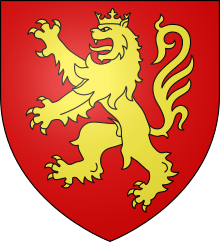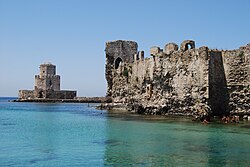William of Champlitte
| William I | |
|---|---|
| Prince of Achaea | |
 Coat of Arms of William of Champlitte | |
| Reign | 1205-1209 |
| Successor | Geoffrey I |
| Born | 1160s |
| Died | 1209 |
| Spouse | Alais of Meursault Elisabeth of Mount-Saint-Jean |
| House | |
| Father | Odo I of Champlitte |
| Mother | Sybille |
William I of Champlitte (French: Guillaume de Champlitte) (1160s-1209) was a French knight who joined the Fourth Crusade and became the first prince of Achaea (1205–1209).[1][2][3]
Early years and the Fourth Crusade
William was the second son of Odo or Eudes I of Champlitte, viscount of Dijon (son of Hugh, Count of Champagne) and his wife, Sybille.[3] He married first Alais, the lady of Meursault. With the consent of his wife, he donated property to the Cistercian abbey of Auberive for the soul of his younger brother, Hugh in 1196.[4] He later married Elisabeth of Mount-Saint-Jean, but they divorced in 1199.
William and his brother,
The crusaders
Foundation of the Principality of Achaea
Early in 1205
From Nauplia William and Geoffrey of Villehardouin made their way north to

The conquerors met their first serious obstacle at the coastal fortress of Arcadia (modern

Although the peninsula had not been entirely overrun—for example
However, the Venetians, in order to secure control of the key ports between Italy and Constantinople, demanded that their rights granted to them by the partition treaty of 1204 be recognized.[19] Early in 1206 they occupied Modon and Coron, expelling the Frankish garrisons.[19]
In 1208 William learned of the death of his brother Louis in Burgundy and decided to return home to France to claim the family lands.[19][20] He left Geoffrey of Villehardouin as acting bailiff to administer Achaea until William's nephew named Hugh should arrive to replace Geoffrey of Villehardouin as bailiff.[19] William, however, died en route home in Apulia.[19][21]
See also
- Fourth Crusade
- Principality of Achaea
- Battle of the Olive Grove of Koundouros
References
- ^ Runciman 1951, p. 126.
- ^ Longnon 1969, p. 239.
- ^ a b Evergates 2007, p. 220.
- ^ Bouchard 1987, p. 121.
- ^ Runciman 1951, p. 115.
- ^ Andrea 2000, pp. 54-56.
- ^ Runciman 1951, p. 111.
- ^ Andrea 2000, p. 55.
- ^ Fine 1994, p. 62.
- ^ Runciman 1951, pp. 124-125.
- ^ a b Runciman 1951, p. 125.
- ^ Setton 1976, p. 16.
- ^ a b c d Fine 1994, p. 69.
- ^ Longnon 1969, p. 237.
- ^ a b c d e f g h i j k l m Setton 1976, p. 25.
- ^ a b c d Fine 1994, p. 70.
- ^ Runciman 1951, p. 124.
- ^ Setton 1976, p. 26.
- ^ a b c d e Fine 1994, p. 71.
- ^ Setton 1976, p. 33.
- ^ Setton 1976, p. 34.
Sources
- Andrea, Alfred J. (2000). Contemporary Sources for the Fourth Crusade. Brill. ISBN 90-04-11740-7.
- Bon, Antoine (1969). La Morée franque. Recherches historiques, topographiques et archéologiques sur la principauté d'Achaïe [The Frankish Morea. Historical, Topographic and Archaeological Studies on the Principality of Achaea] (in French). Paris: De Boccard. OCLC 869621129.
- Bouchard, Constance Brittain (1987). Sword, Miter, and Cloister: Nobility and the Church in Burgundy, 980-1198. Cornell University Press. ISBN 0-8014-1974-3.
- Evergates, Theodore (2007). The Aristocracy in the County of Champagne, 1100-1300. University of Pennsylvania Press. ISBN 978-0-8122-4019-1.
- ISBN 0-472-08260-4.
- ISBN 0-14-044124-7.
- Longnon, Jean (1969) [1962]. "The Frankish States in Greece, 1204–1311". In ISBN 0-299-04844-6.
- Runciman, Steven (1954). A History of the Crusades, Volume III: The Kingdom of Acre and the Later Crusades. Cambridge: Cambridge University Press.
- ISBN 0-87169-114-0.
Further reading
- Finley Jr, John H. "Corinth in the Middle Ages." Speculum, Vol. 7, No. 4. (Oct., 1932), pp. 477–499.
- Tozer, H. F. "The Franks in the Peloponnese." The Journal of Hellenic Studies, Vol. 4. (1883), pp. 165–236.
